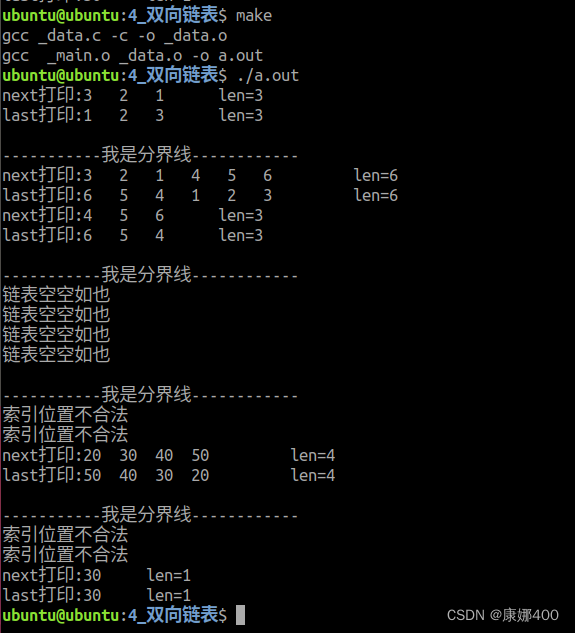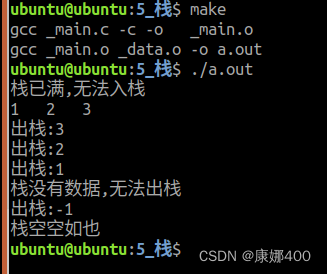1. 双向链表
功能函数
#include <stdio.h>
#include <stdlib.h>
#include "./_data.h"
/*
* function: 创建双向链表头结点
* @param [ in]
* @param [out]
* @return
*/
two_linklist* creat_two_linklist(void)
{
two_linklist* head = (two_linklist*)malloc(sizeof(two_linklist));
if(NULL == head)
{
printf("头结点申请失败\n");
return NULL;
}
head->last=NULL;
head->next=NULL;
head->gcf.len=0;//头节点初始化
return head;
}
/*
* function: 头插
* @param [ in]
* @param [out]
* @return
*/
void insert_top(two_linklist* head,user_type value)
{
//创建节点
two_linklist* temp = (two_linklist*)malloc(sizeof(two_linklist));
if(NULL == temp)
{
printf("结点申请失败\n");
return;
}
temp->gcf.data=value;
//处理next
temp->next=head->next;
head->next=temp;
//处理last
temp->last=head;
if(temp->next!=NULL)//判断后面有无节点,是否队后面节点的last做操作
{
temp->next->last=temp;
}
head->gcf.data++;
}
/*
* function: 尾插
* @param [ in]
* @param [out]
* @return
*/
void insert_bottom(two_linklist* head,user_type value)
{
//创建节点
two_linklist* temp = (two_linklist*)malloc(sizeof(two_linklist));
if(NULL == temp)
{
printf("结点申请失败\n");
return;
}
two_linklist *p=head;//复制头结点地址
temp->gcf.data=value;
for(;p->next!=NULL;p=p->next);//找到尾节点
//处理next
temp->next=p->next;
p->next=temp;
//处理last
temp->last=p;
head->gcf.len++;
}
/*
* function: 头删
* @param [ in]
* @param [out]
* @return
*/
void delete_top(two_linklist* head)
{
if(NULL == head->next)
{
printf("链表空空如也\n");
return;
}
//另存要删除的节点地址
two_linklist* temp=head->next;
//处理next
head->next=head->next->next;
//处理last
if(head->next!=NULL)
{
head->next->last=head;
}
free(temp);
head->gcf.len--;
}
/*
* function: 尾删
* @param [ in]
* @param [out]
* @return
*/
void delete_bottom(two_linklist* head)
{
if(NULL == head->next)
{
printf("链表空空如也\n");
return;
}
two_linklist* p=head;
for(;p->next!=NULL;p=p->next);//找最后一个节点
//另存要删除的节点地址
two_linklist* temp=p;
//处理next
p->last->next=p->next;
//尾部last不需要处理
free(temp);
head->gcf.len--;
return;
}
/*
* function: 位置插入
* @param [ in]
* @param [out]
* @return
*/
void insert_index(two_linklist* head,user_type value,int index)
{
two_linklist * p = head;
//要求一下,不用len做索引判断
int len = 0;
for(;p->next!=NULL;p=p->next,len++)
{
if(index == len+1)
break;
}//p指向的是插入位置的前一个节点
if(index<=0 || index>len+1)
{
printf("索引位置不合法\n");
return;
}
//创建节点
two_linklist* temp = (two_linklist*)malloc(sizeof(two_linklist));
if(NULL == temp)
{
printf("结点申请失败\n");
return;
}
temp->gcf.data=value;
//处理next,p已经在插入位置的前一个节点了
temp->next=p->next;
p->next=temp;
//处理last
temp->last=p;
if(NULL!=temp->next)
{
temp->next->last=temp;
}
head->gcf.len++;
}
/*
* function: 位置删除
* @param [ in]
* @param [out]
* @return
*/
void delete_index(two_linklist* head,int index)
{
if(index<=0 || index>head->gcf.len)
{
printf("索引位置不合法\n");
return;
}
two_linklist * p = head;
for(;index>1;index--,p=p->next);
//创建节点
two_linklist* temp = (two_linklist*)malloc(sizeof(two_linklist));
if(NULL == temp)
{
printf("结点申请失败\n");
return;
}
//另存要删除的节点地址
two_linklist* d=p->next;
//处理next
p->next=p->next->next;
//处理last
if(p->next!=NULL)
{
p->next->last=p;
}
free(d);
head->gcf.len--;
}
/*
* function: 打印链表
* @param [ in]
* @param [out]
* @return
*/
void put_two_linklist(two_linklist*head)
{
if(NULL == head->next)
{
printf("链表空空如也\n");
return;
}
two_linklist* p=head;
printf("next打印:");
while(p->next!=NULL)
{
printf("%-4d",p->next->gcf.data);
p=p->next;
}
printf("\tlen=%d\n",head->gcf.len);
printf("last打印:");
while(p->last!=NULL)
{
printf("%-4d",p->gcf.data);
p=p->last;
}
printf("\tlen=%d\n",head->gcf.len);
}头文件
#ifndef __DATA_H__
#define __DATA_H__
typedef int user_type;
typedef struct node
{
union
{
int len;
user_type data;
}gcf; //数据域
struct node* next;
struct node* last;//指针域
}two_linklist;
two_linklist* creat_two_linklist(void);//创建双向链表头结点
void insert_top(two_linklist* head,user_type value);//头插
void put_two_linklist(two_linklist*head);//打印链表
void insert_bottom(two_linklist*,user_type value);//尾插
void delete_top(two_linklist* head);//头删
void delete_bottom(two_linklist* head);//尾删
void insert_index(two_linklist* head,user_type value,int index);//位置插入
void delete_index(two_linklist* head,int index);//位置删除
#endif主函数
#include <stdio.h>
#include "./_data.h"
int main(int argc, const char *argv[])
{
two_linklist* head=creat_two_linklist();
insert_top(head,1);
insert_top(head,2);
insert_top(head,3);
put_two_linklist(head);
printf("\n-----------我是分界线------------\n");
insert_bottom(head,4);
insert_bottom(head,5);
insert_bottom(head,6);
put_two_linklist(head);
delete_top(head);
delete_top(head);
delete_top(head);
put_two_linklist(head);
printf("\n-----------我是分界线------------\n");
delete_bottom(head);
delete_bottom(head);
delete_bottom(head);
put_two_linklist(head);
delete_bottom(head);
delete_top(head);
put_two_linklist(head);
printf("\n-----------我是分界线------------\n");
insert_index(head,10,0);
insert_index(head,30,1);
insert_index(head,40,2);
insert_index(head,20,1);
insert_index(head,50,4);
insert_index(head,10,6);
put_two_linklist(head);
printf("\n-----------我是分界线------------\n");
delete_index(head,0);
delete_index(head,5);
delete_index(head,1);
delete_index(head,2);
delete_index(head,2);
put_two_linklist(head);
return 0;
}运行结果

2. 顺序栈列
功能函数
#include <stdio.h>
#include <stdlib.h>
#include "./_data.h"
/*
* function: 创建空栈
* @param [ in]
* @param [out]
* @return
*/
stack* creat_stack(void)
{
stack* head = (stack*)malloc(sizeof(stack));
if(NULL==head)
{
printf("创建空栈失败\n");
return NULL;
}
head->pos=0;
}
/*
* function: 入栈
* @param [ in]
* @param [out]
* @return
*/
void insert_stack(stack* head,user_type value)
{
if(head->pos>=N)
{
printf("栈已满,无法入栈\n");
return;
}
head->data[head->pos]=value;
head->pos++;
}
/*
* function: 出栈
* @param [ in]
* @param [out]
* @return
*/
user_type delete_stack(stack* head)
{
if(head->pos==0)
{
printf("栈没有数据,无法出栈\n");
return(user_type)-1;
}
head->pos--;
return head->data[head->pos];
}
/*
* function: 打印栈
* @param [ in]
* @param [out]
* @return
*/
void put_stack(stack* head)
{
if(0==head->pos)
{
printf("栈空空如也\n");
return;
}
for(int i=0;i<head->pos;i++)
{
printf("%-4d",head->data[i]);
}
printf("\n");
return;
}
/*
* function: 释放栈
* @param [ in]
* @param [out]
* @return
*/
void free_stack(stack** head)
{
free(*head);
*head=NULL;
}头文件
#ifndef __DATA_H__
#define __DATA_H__
#define N 3
typedef int user_type;
typedef struct
{
user_type data[N];
int pos;
}stack;
stack* creat_stack(void);//创建空栈
void insert_stack(stack* head,user_type value);//入栈
user_type delete_stack(stack* head);//出栈
void put_stack(stack* head);//打印栈
void free_stack(stack** head);//释放栈
#endif主函数
#include <stdio.h>
#include "./_data.h"
int main(int argc, const char *argv[])
{
stack* head = creat_stack();
insert_stack(head,1);
insert_stack(head,2);
insert_stack(head,3);
insert_stack(head,4);
put_stack(head);
printf("出栈:%d\n",delete_stack(head));
printf("出栈:%d\n",delete_stack(head));
printf("出栈:%d\n",delete_stack(head));
printf("出栈:%d\n",delete_stack(head));
put_stack(head);
free_stack(&head);
return 0;
}运行结果

3. 顺序队
功能函数
#include <stdio.h>
#include <stdlib.h>
#include "./_data.h"
int empty(sequeue* sq)//判断是否为空
{
return (sq->head==sq->tail)?1:0;//返回1为空
}
int full(sequeue* sq)//判断是否为满
{
return ((sq->tail+1)%(N+1)==sq->head)?1:0;//返回1为满
}
/*
* function: 创建队列
* @param [ in]
* @param [out]
* @return
*/
sequeue* creat_sequeue(void)
{
sequeue* sq = (sequeue*)malloc(sizeof(sequeue));
if(NULL==sq)
{
printf("申请失败\n");
return NULL;
}
sq->head=0;
sq->tail=0;
return sq;
}
/*
* function: 入队
* @param [ in]
* @param [out]
* @return
*/
void insert_sequeue(sequeue* sq,user_type value)
{
if(full(sq))
{
printf("队列已满\n");
return;
}
sq->data[sq->tail]=value;
sq->tail=(sq->tail+1)%(N+1);
return;
}
/*
* function: 出队
* @param [ in]
* @param [out]
* @return
*/
user_type leavteam_sequeue(sequeue* sq)
{
if(empty(sq))
{
printf("队列已空\n");
return (user_type)-1;
}
user_type temp = sq->data[sq->head];
sq->head = (sq->head+1)%(N+1);
return temp;
}
/*
* function: 打印
* @param [ in]
* @param [out]
* @return
*/
void put_sequeue(sequeue* sq)
{
if(empty(sq))
{
printf("队列已空\n");
return;
}
int i = sq->head;
while(i!=sq->tail)
{
printf("%-4d",sq->data[i]);
i=(i+1)%(N+1);
}
printf("\n");
}
头文件
#ifndef __DATA_H__
#define __DATA_H__
#define N 3
typedef int user_type;
typedef struct
{
user_type data[N+1];
int head;
int tail;
}sequeue;
sequeue* creat_sequeue(void);//创建队列
void insert_sequeue(sequeue* sq,user_type value);//入队
user_type leavteam_sequeue(sequeue* sq);//出队
void put_sequeue(sequeue* sq);//打印
#endif主函数
#include <stdio.h>
#include "./_data.h"
int main(int argc, const char *argv[])
{
sequeue* sq=creat_sequeue();
insert_sequeue(sq,1);
insert_sequeue(sq,2);
insert_sequeue(sq,3);
insert_sequeue(sq,4);
put_sequeue(sq);
printf("%d\n",leavteam_sequeue(sq));
printf("%d\n",leavteam_sequeue(sq));
printf("%d\n",leavteam_sequeue(sq));
printf("%d\n",leavteam_sequeue(sq));
insert_sequeue(sq,1);
insert_sequeue(sq,2);
insert_sequeue(sq,3);
insert_sequeue(sq,4);
put_sequeue(sq);
return 0;
}运行结果






















 1492
1492

 被折叠的 条评论
为什么被折叠?
被折叠的 条评论
为什么被折叠?








